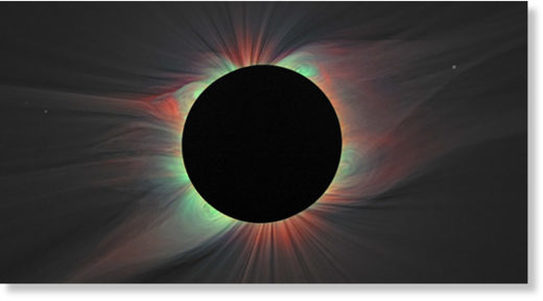The probe recorded a fast-moving wave in the thermosphere go by half an hour after sunset in São João do Cariri and 55 minutes after the end of the total eclipse, the team reported April 24 in Geophysical Research Letters. The wave is produced by the motion of the moon's shadow, which cooled the atmosphere below it. That cold spot then acted like a sink, sucking in the warmer air ahead of it and causing a ripple in the atmosphere as the cold spot moved across the globe.
Previous eclipses also have launched waves at similar altitudes in the ionosphere, the charged plasma of the atmosphere, which overlaps with the electrically neutral thermosphere (SN Online: 8/13/17). This is the first time that scientists have observed a wave in the uncharged part of the atmosphere. Neutral particles are 100 to 1,000 times denser than plasma in the atmosphere, and it's important to know how they behave too, Harding says.
This simulation predicts the atmosphere’s response to a solar eclipse. Color shows how temperature changes, and black lines trace motion in the atmosphere. The moon’s shadow cooled the atmosphere, producing a large wave that was visible from a research station in Brazil (black square) after the eclipse had ended. Read more: https://www.sciencenews.org/article/g... Credit: B.J. Harding et al/Geophysical Research Letters 2018.
https://www.sott.net/article/384617-Last-years-solar-eclipse-set-off-a-wave-in-the-upper-atmosphere-that-was-detected-as-far-away-as-Brazil

 RSS Feed
RSS Feed